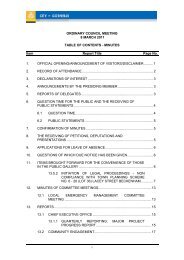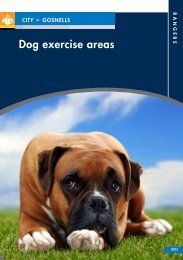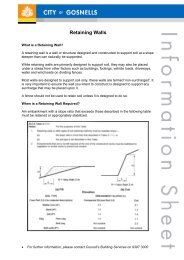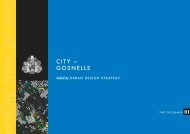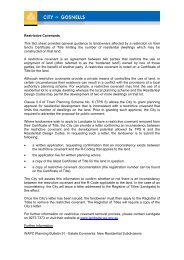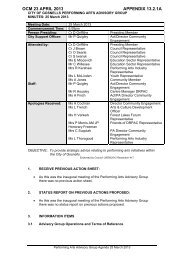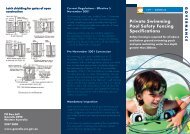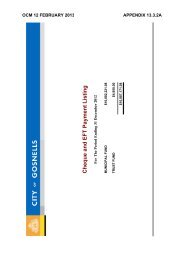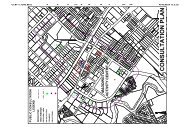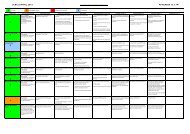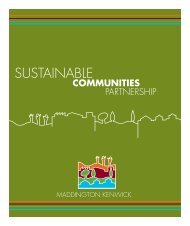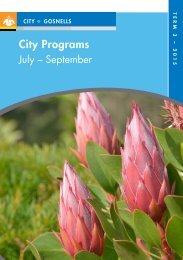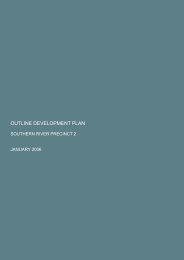Vegetation 73that they may be underlain by Muchea Limestone. However, Site 20 showed evidence <strong>of</strong> calcareous materialin the shallow sediments.Sites 7 and 31 were narrow zones dominated by Pericalymma ellipticum that were not included in themultivariate analysis because they were thought to be transitional zones between other vegetation units.Pericalymma ellipticum dominated shrubs are not uncommon in BFS 387 (Table 4.4) where they occureither as an understorey in FCT 3a or as narrow zones on gentle slopes (as they do in Sites 7 and 31 in theMKSEA) that are flanked on the upland side by low lying Banksia woodland (FCT 21c) and downslope byspecies-rich rush/sedge/herblands <strong>of</strong> FCTs 7 and 8. MKSEA Sites 7 and 31 were most similar to FCT 10a, asinferred from species lists in Table 12 (Gibson et al., 1994).Assignation <strong>of</strong> FCTs (Table 5.5, Column 6a)Sites 4 and 5 were assigned to the Muchea Limestone TEC as this best reflected the total data available forthis area.Sites 6 and 14 were assigned to FCTs 7/8 as apart from their species-richness and the results <strong>of</strong> the floristicanalysis which tended to indicate FCT 8, they were inundated for a lengthy period each spring and theyincluded aquatic species.Sites 20 and 21 were assigned to the Muchea Limestone TEC as this best reflected the total data available forthis area.Site 18 was cleared shortly after the survey; the floristics indicated FCT 8 or 10a.Sites 8 and 11 were species-rich with numerous shrubs as well as geophytes, did not include aquatic speciesand were not inundated (except for short periods after rain). The floristic analysis indicated an affinity withFCT 8 and the ecological data with FCT 10a. These sites were tentatively assigned to FCTs 8/10a.Sites 9, 10 and 18 were species-rich with annuals and geophytes, did not include aquatic species and werenot inundated (except for short periods after rain). The floristic analysis indicated an affinity with FCT 8, theecological data with FCT 10a and floristic indicator species (except for Site 18) with ML. Sites 9 and 10were tentatively assigned to FCTs 8/10a/ML pending further hydrogeological investigation.Sites 7 and 31 were tentatively assigned to FCT 10a, as inferred from species lists in Table 12 (Gibson et al.,1994).From the above, the vegetation <strong>of</strong> Sites 4, 5 and 20 should be regarded as part <strong>of</strong> the complex <strong>of</strong> vegetationtypes associated with the Muchea Limestone Threatened Ecological Community (EPBC CategoryEndangered). The other blocks that included sites provisionally assigned to FCTs 7, 8 or 10a require furtherhydrogeological investigations to determine the Muchea Limestone issue. Pending these investigations, all <strong>of</strong>the remnant vegetation <strong>of</strong> Sites 6, 8, 9, 10 and 11 Rd should be protected as representatives <strong>of</strong> the complex <strong>of</strong>FCTs (7, 8, 10a) that are part <strong>of</strong> the mosaic <strong>of</strong> very species-rich seasonal wetland vegetation <strong>of</strong> the GuilfordVegetation Complex.Group D. MLResultsThe MKSEA quadrat sites 15, 16 presented a very ambiguous pattern in relation to the SCP dataset and thevegetation <strong>of</strong> these sites was also unlike any other vegetation previously recorded in BFS 387 or BFS 53.The investigations in the current survey showed that an active spring (associated with Muchea Limestone)contributed to the maintenance <strong>of</strong> the wetland and vegetation at Sites 15, 16 and probably to some extent toSite 14. Unlike the other wetlands <strong>of</strong> the MKSEA that were investigated in this survey and other wetlands <strong>of</strong>BFS 387 (VCSRG, 2001) the water table <strong>of</strong> the wetlands at Sites 14 and 15 was constantly high, the arearemained waterlogged throughout the year and there was a layer <strong>of</strong> peat at the ground surface. Theunderstorey <strong>of</strong> Site 15 was dominated by the sedge Cyathochaeta teretifolia. This sedge is rare In the PerthMetropolitan Region this sedge is known from Whiteman Park, Lake Gnangara, Ellenbrook, Bullsbrook,Pinjar, Wanneroo and Muchea but is rare on the Pinjarra Plain and south <strong>of</strong> the Swan River. It is usuallyassociated with artesian springs or other hydrological settings that are uncommon on the SCP (for anexample <strong>of</strong> such unusual settings see the listing for the Egerton Mound Spring on pages 226-227 inGovernment <strong>of</strong> Western Australian, 2000). This species is no longer extant in many locations on SCP whereTauss, C. and Weston, A.S. (2010). The flora, vegetation and wetlands <strong>of</strong> the Maddington-Kenwick Strategic Employment Area.A survey <strong>of</strong> the rural lands in the vicinity <strong>of</strong> the Greater Brixton Street Wetlands. Report to the <strong>City</strong> <strong>of</strong> <strong>Gosnells</strong>, W.A. Version 18.04.10
Vegetation 74it was recorded previously (including Bassendean and Midland). There are a number <strong>of</strong> other regionallysignificant species in Sites 15 and 16, including Thysanotus arenarius (a calcicole species that is an indicator<strong>of</strong> ML on the Pinjarra Plain), Burchardia bairdiae, Gastrolobium ebracteolatum, Prasophyllum drummondii,Sphaerolobium vimineum and Utricularia inaequalis.Assignation <strong>of</strong> FCTs (Table 5.5, Column 6a)The vegetation <strong>of</strong> Sites 15 and 16 should be regarded as part <strong>of</strong> the complex <strong>of</strong> vegetation types associatedwith the Muchea Limestone TEC.From the data collected in the current survey and the (sometimes ambiguous) trends expressed by the results<strong>of</strong> the multivariate analysis <strong>of</strong> these sites against the SCP dataset, Sites 4, 5, 19, 20, 21 and 26 were assignedto the Muchea Limestone TEC (see Groups A and C above).Sites 8, 9, 10, 11 and 18 were tentatively assigned to FCTs 8/10a pending further hydrogeologicalinvestigation <strong>of</strong> the contribution <strong>of</strong> Muchea Limestone aquifers to the maintenance <strong>of</strong> vegetation in theseareas (see Group C above).Group E. Degraded SitesResultsSites 1, 3, 25, 29 and 32 were relatively degraded sites. Sites 1 and 3 were wetland sites on GuildfordFormation sediments and Sites 25 and 29 were upland sites on Bassendean Sands.Assignation <strong>of</strong> FCTs (Table 5.5, Column 6a)These sites were not reliably assigned to FCTs by the floristic analysis and there was insufficient otherevidence to further inform the analysis results. Sites 1 and 3 were probably most similar to Sites 4 and 5before disturbance.Sites 25 and 29 were probably not part <strong>of</strong> FCT 20a but the more common FCT 23a that has been recordedpreviously in BFS 387 (Government <strong>of</strong> Western Australian, 2000).Group F. Unassigned SitesResultsMKSEA Site 2 was too weedy for assigning it to any FCT, and Site 27 presented a very ambiguous pattern inrelation to the SCP dataset. The vegetation <strong>of</strong> this site was also unlike any other vegetation previouslyrecorded in BFS 387 or BFS 53.Site 27 was not able to be investigated in as much detail as the other sites due to access problems. There wasno evidence <strong>of</strong> calcareous material at the site (although one calcicole species Thysanotus arenarius wasrecorded) and the water table was relatively low. Unlike Sites 15 and 16 there was no evidence <strong>of</strong> a welldevelopedpeat layer in this wetland. However, the vegetation recorded at this site had species that wereundeniably obligate and facultative wetland species. The unusual wetland vegetation at this site appearedsomewhat at odds with the physical conditions at the site.Assignation <strong>of</strong> FCTs (Table 5.5, Column 6a)It was not possible to assign Site 27 to any FCT or TEC. This area requires further hydrogeologicalinvestigation to determine the habitat. However, as intact remnant vegetation <strong>of</strong> the eastern SCP this areahas, at least, high regional significance.Tauss, C. and Weston, A.S. (2010). The flora, vegetation and wetlands <strong>of</strong> the Maddington-Kenwick Strategic Employment Area.A survey <strong>of</strong> the rural lands in the vicinity <strong>of</strong> the Greater Brixton Street Wetlands. Report to the <strong>City</strong> <strong>of</strong> <strong>Gosnells</strong>, W.A. Version 18.04.10



